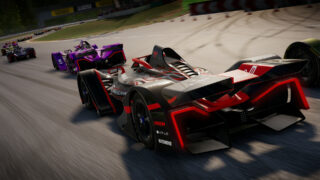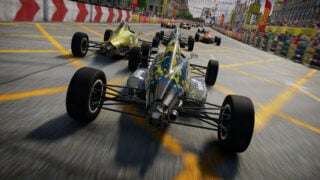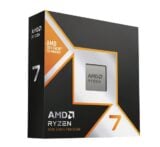Hands-On: GRID Legends is putting its Story mode front and centre
Codemasters’ latest is plotting a satisfying single-player experience

Codemasters is obviously well known for its expertise in racing games, but that’s only half the story (literally).
The studio is particularly adept when it comes to adding plots to its racing titles, and nowhere has this been more apparent than its Race Driver series, which began two decades ago and evolved to become the GRID series over the years.
GRID Legends is the latest game in the series – the fifth GRID game or the eleventh Race Driver game, depending on how you’re counting – and this time Codemasters is leading with the story aspect by placing it front and centre in the lead-up to the game’s release on February 25.
We recently had a chance to go hands-on with the first six chapters of this story, and while it’s far too early to make an overall judgement on such a small section of the game – a little under an hour’s worth – it’s certainly whetted our appetite for what’s to follow.
The game’s story mode puts you in the overalls of the mysterious Driver 22, an up and coming racer who’s appointed at the last minute to join Seneca Racing, a struggling racing team whose owner Marcus Ado is at his wit’s end due to the loss of his number two racer.
Driver 22 is plucked from the amateur scene and slotted in to fill the gap, much to the annoyance of Seneca’s main driver Yume Tanaka, who understandably isn’t impressed that she’s being made to partner up with a complete unknown.
It’s up to the player, as Driver 22, to first establish themselves as a legitimate racer and then, presumably, gain Yume’s trust as you both try to work together to win the season. Though, naturally, you can expect a few twists and turns along the way, and not just those on the track.
Each of the six chapters we played were preceded by live-action cutscenes, played out by professional actors. For example, Ncuti Gatwa, who starred in Netflix’s Sex Education series, plays your main rival in the game.
These scenes are shot using virtual production methods which are similar to those used in The Mandalorian, which put its actors in front of state-of-the-art video screens instead of more conventional greenscreens.
“The cutscenes are shot using virtual production methods which are similar to those used in The Mandalorian, which put its actors in front of state-of-the-art video screens instead of more conventional greenscreens.”
Behind-the-scenes interviews on the making of The Mandalorian suggested that the cast preferred working like this because their performances were improved by the fact they could actually see their setting, rather than just a big green wall around them.
It’s too early to tell at this point whether GRID Legends has had a similar impact on its cast, and so far most of the examples we’ve seen have involved things like scenes in the paddock with out-of-focus CGI-generated racetracks in the background.
Granted, the results so far are perfectly acceptable and may mark the future of less expensive productions going forwards, but we’re curious to see whether this new filming technique is used for greater impact later on in the story.
The only issue we have at this point is that the story is so firmly locked in place and rigidly linear that you may have to spend time finding a difficulty level that lets you barely achieve each task, otherwise it can make for a discrepancy between the narrative being told and the actual performance you’re putting in.
For example, we played on the default difficulty, which racing game veterans will find pretty easy, and the result of this is that we were getting results beyond what the game was expecting at this point in Driver 22’s career.
One early race asks you to finish ahead of another racer, who’s generally found in the back half of the pack. We overtook them with relative ease and went on to win the race, which made for awkward moments where we were entering the final lap in first position while at the same time being told in our headset to “keep pressure” on the guy we’d already left in our dust.
The same goes for one of the later races we played in which, upon joining Seneca, your role is simply to finish at least 10th in order to ensure your team isn’t embarrassed by a shambolic debut performance.
If you finish in first place instead, nobody acknowledges the fact that this complete newcomer has suddenly won his debut race, and the game continues as if you’d achieved the expected 10th place goal, with your partner still doubting your talents.
This issue aside, GRID Legends looks set to be more of the same from Codemasters, and we mean that in the most positive way imaginable.
“GRID Legends looks set to be more of the same from Codemasters, and we mean that in the most positive way imaginable.”
The Story mode isn’t the only thing the game has to offer, and while it was all we’ve played at this point, Codemasters promises the full game will have a separate Career mode with over 250 events, as well as 130 routes in new and returning tracks and over 100 cars at launch.
It’s just as well, because based on the locked chapters in Story mode it looks like we’ll be getting around 5-6 hours there, a short but sweet narrative that shouldn’t outstay its welcome.
This would be an issue if that was all there was on offer, but the fact there’s going to be plenty of variety there to keep you going long after the credits roll on the Story makes us keen to see what the full package entails.
Ultimately, we know that Codemasters will deliver on the gameplay side of things. That the studio will deliver solid racing action simply can’t be questioned at this point in the studio’s life, and what we’ve played gives us no reason to suggest this will be anything other than a great racer.
What remains to be seen, however, is whether the Story mode’s plot will be similarly engaging, or whether it will simply be a sideshow to the main event that may be Career mode.





















